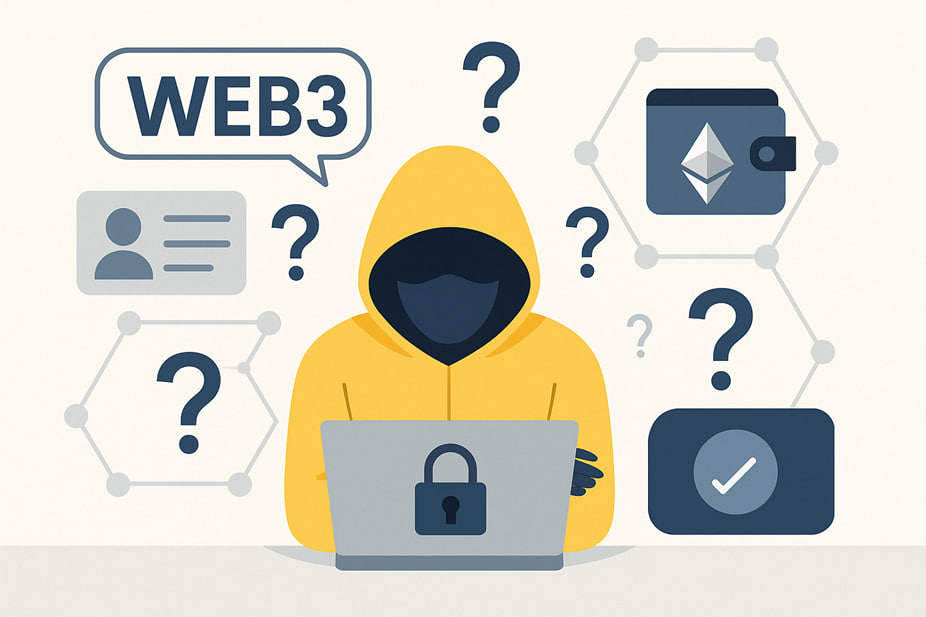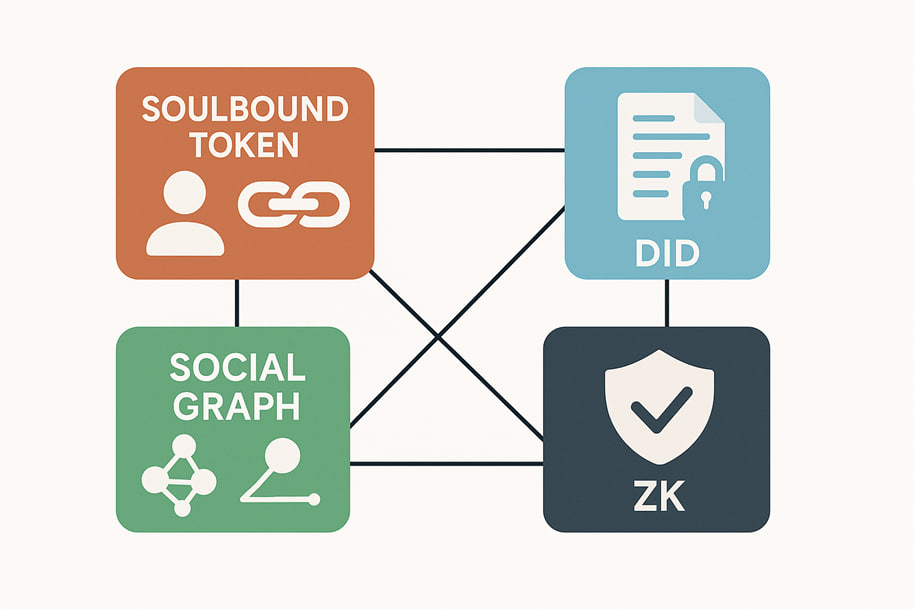The Web3 Identity Problem and Why Proof-of-Trade Solves It

Contents
- Introduction
- What Is the Problem of Identity in Web3
- Why Traditional Solutions Do Not Work
- What Is Proof-of-Trade
- How Proof-of-Trade Works in Practice
- Advantages of the Proof-of-Trade Approach
- Where Proof-of-Trade Is Already Used
- Limitations and Challenges
- Alternative Approaches to On-Chain Identity
- Conclusion
Introduction
In Web3, there is no reliable identification system in place. Almost all users act anonymously or under pseudonyms. This is convenient, but it creates many difficulties: it is hard to understand whom you can trust and whom you should deal with. Anonymity hinders the building of trust and reputation, without which practical cooperation in decentralised systems cannot function.
One possible solution is the concept of proof of trade. It is built on the idea that if a user conducts honest and transparent trading activity, this can serve as the basis for their reputation. Such a system can become an identity layer for DeFi and other Web3 projects.
What Is the Problem of Identity in Web3

No Single Identifier
A user can create as many wallets as they like, and none of them is linked to their history or behaviour. This prevents the creation of a full-fledged decentralised identity—the kind where control over identity remains with the user, yet it is still possible to verify their reliability.
Reputation cannot Be Evaluated.
If a user does not have a stable profile, others cannot assess them as a network participant. Today, they may act as a valuable contributor, and tomorrow, they can create a new wallet and act in their interests without facing consequences. Without a reputation in Web3, it becomes challenging to launch long-term projects or build trust between unfamiliar parties.
No Cumulative Reputation System
In traditional online services, a person builds up a rating based on reviews, scores, purchase history, or activity history. In Web3, there is no such system. A user’s actions are not collected in one place. This makes it impossible to apply the idea of on-chain reputation—a model based on actual behaviour recorded on the blockchain.
Vulnerability to Sybil Attacks
If anyone can create hundreds of wallets, they may try to influence voting, grab an airdrop, or cheat the system. This is known as a Sybil attack. It undermines trust and makes honest participation impossible. Without resistance to such attacks, it is challenging to build a healthy reputation system without intermediaries.
Malicious Behaviour Goes Unpunished
When no one is accountable, some users may harm others by exploiting insider information, falsifying activity, or manipulating data. This prevents the emergence of meaningful identity in cryptocurrencies, where behaviour should reflect a person’s actual value to the ecosystem.
Why Traditional Solutions Do Not Work
In Web2, we use passports, phone numbers, email addresses, or social accounts for verification. These rely on centralised systems and trust in a specific company or authority. But Web3 works differently.
- Firstly, there is no central authority in Web3. That makes KYC (know your customer) a poor fit—it requires personal data to be shared with third parties, which contradicts the principles of blockchain infrastructure.
- Secondly, crypto infrastructure operates globally. Users may reside in countries with different laws, often without access to recognised ID. This exclusion excludes millions from participating in the Web3 economy.
- Thirdly, using email or social logins ties identity to external platforms, inviting censorship and surveillance. In a decentralised world, these risks are unacceptable. That’s why the community seeks blockchain-native methods to verify trust without exposing identities.
Web3 needs other solutions that are native to blockchain. One such solution is proof-of-trade.
What Is Proof-of-Trade

Proof-of-trade is a method of confirming identity and reputation based on a user’s trading history on the blockchain. Instead of asking for a passport or phone number, the system looks at the person’s behaviour: how they trade, interact with protocols, and what actions they perform.
This model builds reputation through actions, not documents. It matters especially in Web3, where the wallet—not a name—is the core unit.
An on-chain identity based on proof-of-trade helps assess how trustworthy someone is without relying on centralised sources. It uses open transaction history and interactions to build a user profile. This profile can unlock access to DeFi protocols, DAO participation, or special rewards.
This approach addresses several problems simultaneously: it enhances trust, prevents forgery, and maintains anonymity. It lays the groundwork for a Web3 reputation that works without intermediaries and is controlled by users themselves.
How Proof-of-Trade Works in Practice
Here’s a step-by-step explanation:
- Collecting Data from the Wallet
First, the protocol analyses the user’s wallet. It checks past transactions, which protocols the user interacted with, and how often actions occurred. This happens automatically—blockchain data is public and easily accessible. - Analysing Trading Activity
The system examines the types of trades, including swaps on decentralised exchanges, participation in liquidity pools, token trading, and staking. It also considers volume, frequency, and variety. This helps to measure how active and experienced the user is. - Creating an On-Chain Profile
Based on this data, the protocol creates an on-chain identity. It’s not tied to a name, but it reflects how the user behaves. This profile functions like a digital business card—actions, not claims. It’s reputation, built up through trading over time. - Using the Profile Across Protocols
Once a user has such a profile, they can utilise it across various Web3 projects, gaining access to new DeFi platforms, joining DAOs, bypassing KYC screenings, or receiving perks in games and NFT collections.
Advantages of the Proof-of-Trade Approach

The proof-of-trade method has several strengths that make it ideal for Web3:
- Hard to Fake
Users can’t create a fake record. Everything is written to the blockchain and cannot be erased. This ensures a high level of trust. It helps to stop Sybil attacks and fake accounts. - Objective Data
The system reviews real behaviour—not claims or documents. This removes the need for intermediaries, because the protocol evaluates the user directly. - Enables Ratings and Access Levels
Developers can use these profiles to build access tiers—for example, only allowing users with a particular trading record. This creates reputation-based filters without logins, passwords, or document checks. - Works Without KYC
One of the most significant benefits is freedom from centralised checks. Replacing KYC with on-chain reputation makes crypto services more accessible and fair. This is vital for people in countries without access to banks or traditional tools. - Respects Privacy
The user stays anonymous, but their behaviour is visible. This gives a balance between freedom and responsibility. It supports the idea of pseudonymous identity—you act under an address, but your actions still matter.
Where Proof-of-Trade Is Already Used
The proof-of-trade mechanism is becoming the foundation of reputation in many Web3 projects. Here are a few examples:
Arcx
This platform creates trading passports. They show how often someone trades, how stable their results are, and which protocols they use. Users with strong financial histories are eligible for benefits such as lower fees, special privileges, and higher limits.
Credential Protocol
Credential collects users’ Web3 achievements: voting, staking, and using DeFi platforms. It builds a digital reputation profile, which can be used to apply for DAOs, airdrops, or testnets.
Masa Finance
Masa builds an on-chain profile based on user activity, including trading history, DeFi participation, and other relevant factors. It’s useful for loans, early access to projects, or non-KYC verification.
TradeLink Passport
TradeLink enables traders to link exchange accounts via a read-only API and share precise trading statistics. It collects live data on volume, profits, and strategies to build a transparent profile. This passport not only replaces screenshots and empty claims when dealing with investors or partners — it also helps traders themselves. By tracking full performance metrics over time, users can identify mistakes earlier, determine what works best, and refine their trading decisions.
Karma3 Labs
This project builds a decentralised reputation system. It tracks how users vote in DAOs, use protocols, and interact with others. The system works like PageRank for Web3, showing who contributes and who simply watches.
Limitations and Challenges
Despite its strengths, proof of trade doesn’t solve everything. There are some significant drawbacks:
- Limited Data for Newcomers
If someone is new to Web3, they have no history. Their wallet looks empty, and they might be denied access. This makes DeFi onboarding more challenging and could deter new users. - Behaviour Manipulation
If users know they earn rewards for activity, they might start “gaming” the system—moving tokens between their wallets to boost scores. This introduces noise and distorts on-chain behaviour. - Privacy and Regulation Issues
Proof-of-trade doesn’t ask for documents, but it still analyses behaviour. This raises questions: does it invade privacy? What happens if a profile is used across countries with different laws? Some people may not want to leave a permanent digital footprint.
Alternative Approaches to On-Chain Identity

Proof-of-trade isn’t the only way to build identity in Web3. Other models offer different strengths and weaknesses.
- Soulbound Tokens
These tokens can’t be transferred and remain linked to a single wallet. They can show achievements, event attendance, or awards. The idea is simple: if it can’t be sent away, it reflects the user. However, this method doesn’t always accurately reflect current behaviour. Proof of trade offers better insight into recent activity. - DID (Decentralised Identifiers)
DID creates a unique ID under the user’s control. They can attach data or verifications—such as a passport issued by a government. It’s flexible, but doesn’t prove they’re active on the blockchain. - ZK Proofs (Zero-Knowledge Proofs)
These allow users to prove they’ve done something without revealing details—for example, holding assets or having experience. This helps with privacy. But these proofs are complex and challenging to scale. Proof-of-trade is more straightforward and more adaptable. - Social Graphs
Some projects map who interacts with whom. Being connected to trusted users improves your standing. This approach works in communities but can be compromised by fake links. It’s less reliable in new networks. Compared to this, trading history gives a more accurate view.
Overall, proof-of-trade stands out because it’s transparent, simple, and shows real actions.
Conclusion
Identity in Web3 remains one of its most significant open problems. Without a clear trust system, it’s hard to build honest protocols, grow DAOs, or welcome new users. Old Web2 tools don’t work—they break privacy and go against decentralisation.
Behaviour-based models point in a new direction. They focus not on names, but on what people do. This is a fair way to measure someone’s role—without asking for private documents.
Proof of trade is a key step in that direction. It turns trading history into on-chain reputation. That helps identify trustworthy users, avoid fake accounts, and grow trust without intermediaries.
These models aren’t just a convenience. They are the basis for a new kind of internet, where reputation comes from actions, not paperwork. That’s why the identity layer in Web3 must be built on practice—not promises.